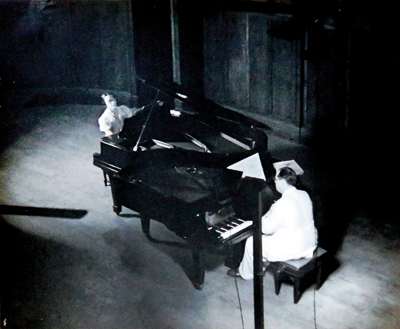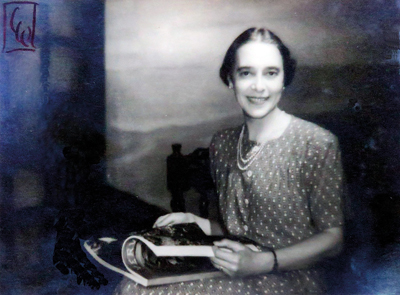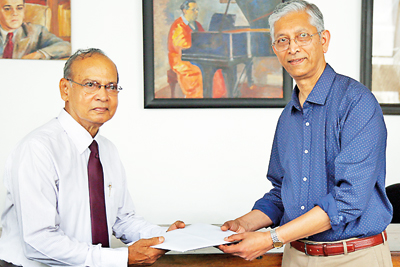My friend Lionel

A shared passion for music: Gladys Forbes and Lionel Wendt at a two-piano concert
Lionel Wendt is a name well known in Sri Lanka, famous in the art world and for founding the 43 Group of modern artists. Less well-known is his association, friendship and influence with musicians, such as Brian Easdale, Hilda Naidoo and Gladys Forbes, with whom he shared recitals and concerts. Of these, the pianist Gladys Forbes would have performed more music with Lionel and over a longer period than any other musician.
They began playing music for two pianos in about 1931 and continued recitals with the Ceylon Music Society until late 1943.
From the mid-30s, after Lionel had taken up photography as a profession, he introduced this art to Gladys, and under his guidance she became a successful exhibitor at the annual exhibitions of the Ceylon Photographic Society.
Both Gladys and Lionel studied piano music for 4 to 5 years in Britain. Gladys studied piano and singing in Edinburgh during 1914-19 after which she returned to Colombo to professional teaching and concert work. Lionel, about three years younger than Gladys, studied piano during 1920-24 at the Royal Academy of Music in London. As Gladys Mackie, before marriage in 1919 to Oswald Forbes of Colombo, she was living in Edinburgh close to her Mackie relatives, artists Charles Mackie, RSA, RSW, and his sister Annie Mackie; so she became much interested in the visual arts. Likewise, in London Lionel developed a special interest in modern art. So their association in Colombo blossomed into a friendship with strong common interests in a broad range of arts.
In 1959, after her husband Ossie Forbes retired from his family’s business Forbes & Walker, tea and rubber brokers in Colombo, they moved to live in London, where Ossie died in 1976 and Gladys in 1978.
She bequeathed to her eldest nephew Bill Mackie a collection of photographs, letters and postcards given to her by Lionel Wendt, together with a number of her own photographs submitted to the Ceylon Photographic Society meetings and annual exhibitions from 1936 until 1942.
From the early 1930s Lionel produced postcard sized prints of self-portraits that he annotated with very humorous, brief notes. These postcards were sometimes sent with Christmas greetings and at other times with perhaps self-deprecating comments; they built among his many friends quite a reputation for his extraordinary sense of humour.
Several of the photos given by Lionel to Gladys are substantial in size, depicting Gladys playing the piano as a soloist and in a two-piano concert setting.
Also in Gladys’s collection are several small prints — portraits taken with Lionel’s Baby Rolleiflex, presumably in the early thirties.

A portrait of Gladys taken by Lionel Wendt-his initials are seen top left
Together with a large print of an often published self-portrait of Lionel, he also gave Gladys a large, but little known, print of himself at his own piano in the living room of Alborado.
About 10 letters from Lionel were retained by Gladys; some were about arrangements he was making about music he intended to play but mainly they were about his personal wellbeing, and written between 1940 and just before he died in 1944. One letter started on April 10, 1944 about a visit to his dentist, ‘Tuesday 11th, 10 a.m. Got back, 1⁄2 an hour ago. The block-busting (8 teeth) was not as bad as I feared, worse than I hoped.’
These mementos, retained by Gladys for 34 years after his death, throw light on the very close friendship they shared.
Especially significant is his giving her a unique copy of the letter he wrote and enclosed with a collection of small treasures that he placed in a copper casket, which in 1928 he buried in the concrete foundations of his new home Alborado as a sort of ritual to wish the best outcomes for the new building. The 3-page letter placed in the casket ended with Lionel’s special wish: ‘May this house prosper. May all honest endeavour in the service of Beauty flourish therein, and win the reward of inward content and Peace that is only in ceaseless effort.’
The building of the Lionel Wendt Memorial Art Centre and its popular usage today leave no doubt that Lionel’s wishes have been and will continue to be fulfilled.
A mysterious item in Gladys’s effects is a leather-bound folder with 37 pages typed by her, each page with one sonnet, most with no title and all of unknown authorship. Two of the sonnets carry dates in their headings; the earliest is the 21st of the 37 sonnets that has the date January 17, 1935; the second last has December 14, 1937 at its heading.
All the sonnets have one theme that extols the appreciation and understanding of aesthetic beauty as expressed by an unidentified female acquaintance of the author, whose admiration for her is shown in the second stanza of the first sonnet.
For thanks to you, sweet singer, singing more
Than songs of words and music made by men
Faint echoes of elusive harmonies
Expressed more clearly in yourself are these
The shrine of loveliness I see again
Again am suppliant at that sacred door.
There is a suspicion based on circumstantial evidence and held by a couple of Gladys’s relatives that Lionel was the author.
In 2010, Neville Weereratne, who had been given a transcript of all the sonnets, sought the advice of Lester James Peries, who at that time was the only surviving colleague of Lionel. In part of his reply to Weereratne, Lester stated;
‘Now, could he be the author of those extraordinary sonnets? I would like to believe he was the author but to my knowledge he was a brilliant prose writer. I had never seen nor heard of him as a poet. (However), reference the sonnets.Lionel Wendt could very well have been the author. The relationship between Lionel and Gladys Forbes was unusually intimate, true, but passionate? I certainly think not in a physical sexual context.’
Today doubt still exists about the authorship of these sonnets– might they indicate the depth of Lionel’s affection for and admiration of Gladys?
(With help from Dr Srilal Fernando and Hugh Karunanayake from Melbourne)
| The scroll comes back home | |
 Dr. Srilal Fernando (right) presenting Gladys Forbes’s copy of the scroll to LWMF chairman Selvam Canagaratna In late 2017, the Lionel Wendt Memorial Fund (LWMF) invited the public to aid them in their newest and biggest project – creating an archive of Lionel Wendt, his work and the Centre for the Arts built in his memory. Six months on, the LWMF has collected and been gifted several antiques, literary and artistic treasures; each with some significance to the life of the Renaissance man himself. On Monday June 25, the Fund made another addition to their collection, this time from across the seas when Dr.Srilal Fernando presented to Chairman, Board of Trustees of the LWMF, Selvam Canagaratna a copy of the scroll buried by Lionel Wendt during the building of his home Alborado. The scroll had been donated by 96-year-old William Mackie in Australia who had came across the LWMF appeal for material on Wendt online. Mr. Mackie’s gift of the handwritten copy of the buried letter had been given to him by his aunt Gladys Forbes.  William Mackie |


